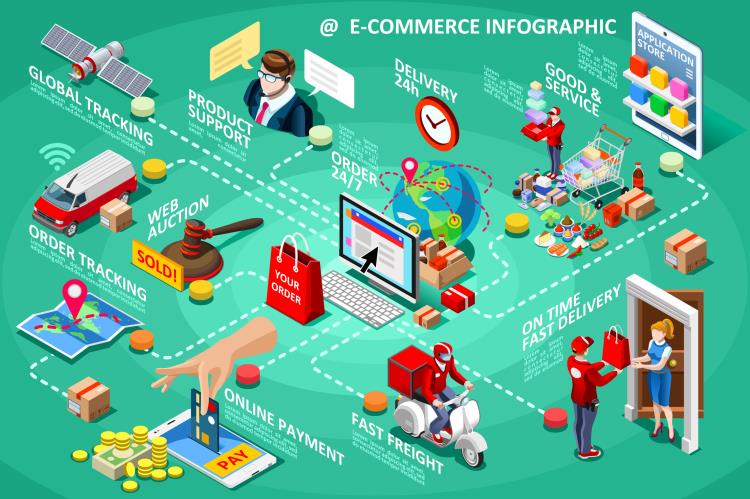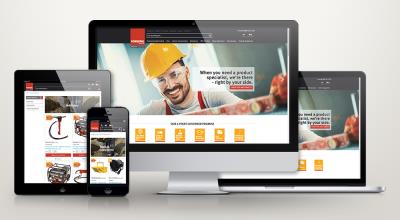E-Commerce and EDI can streamline your sales processes with better customer service to improve your business performance.

E-Commerce
E-Commerce (Electronic Commerce) is not just simply about buying and selling goods and services online. It has become a lot more to include marketing, customer relationship management and customer service. In the past few years E-Commerce has emerged to become an integral part of doing business.
Electronic Data Interchange (EDI)
The earliest form of E-Commerce was EDI, which is the computer-to-computer exchange of business records between business partners such as purchase orders, advanced shipping notices and invoices. EDI requires a standard electronic format between business partners.
EDI replaces mail, fax and email which must be manually handled by customer and supplier staff and processed through their respective systems. Having people involved slows down the processing of the records and also introduces the potential of errors. Instead, EDI records can flow straight from the sender's system to the receiver's system. This speeds up processing of the orders improving delivery times.
The benefits of EDI are are reduced cost, streamlined administration, improved information flow, reduced errors and closer relationships with business partners. Because electronic transactions are so efficient, customers that use EDI prefer to work with suppliers that have EDI systems in place.
EDI is growing despite the rapid increase in online sales in web stores. EDI network traffic volumes increased between 5% and 10% during 2017 and that trend is set to continue for at least the next five years. EDI transaction volume is currently in the range of 12 to 15 million transactions a day worldwide. The continued growth of EDI means it will continue to be the dominant document exchange alternative for many years to come.
Business-to-Business (B2B) E-Commerce
Online sales have been dominated by the rapid growth of B2C E-Commerce, but B2B E-Commerce is poised to take off. Frost & Sullivan (a research consulting company) predicts that in 2020 the B2B E-Commerce market will be twice the size of the B2C E-Commerce market. They predict that 2020 will see worldwide sales reach $12 trillion compared to $5.5 trillion in 2012.
B2B E-Commerce is transitioning from being seller driven to buyer driven, with customer experience being a key focus. The appeal of B2B E-Commerce to business buyers is that they can do research online to find the type of product that meets their needs. They can research detailed specifications, compare options and share their findings with their colleagues. They prefer to buy online once they are sure what they want to buy and often make decisions before speaking to a sales rep.
B2B E-Commerce is becoming a more important means for businesses to promote their product range and introduce new products to new and existing customers alike. Business to business relationships tend to be longer term with repeat orders so it is important to provide the right experience for them.
B2B buyers expect a personalised, seamless shopping experience including search, product relationships, rich product information and specifications, self service customer portals, inventory availability, shipping time and freight charges.
M-Commerce (Mobile Commerce)
Mobile commerce is rapidly becoming more popular for B2B as well as B2C applications. Mobile use is ingrained in our everyday habits and now most people start a search for products or services on their mobile device rather than on a computer. Web stores now need to be mobile friendly more than ever before.
Business to Consumer (B2C) E-Commerce
B2C is currently the most common form of E-Commerce and it is dramatically changing the retail industry. The dramatic growth in B2C online sales shows no sign of abating.
The Australian retail industry is worth $300bn. While B2C E-Commerce accounts for only 8-13% of that, it is a sector that is rapidly growing. Statistica (a research consulting company) reported that in 2016 E-Commerce retail sales in Australia amounted to $US9.58 billion and that sales are projected to grow to $US15.49 billion in 2021. According to a recent Neto report, 25.1% of Australian shoppers purchase online at least once a week.
Yet bricks-and-mortar retail is not declining with 90% of retail sales worldwide being made in stores. The IHL Group (a research consulting company) reported a net increase in store openings of over 4,000 in 2017. In fact, for each company closing a store, 2.7 companies are opening stores.
Retail is a highly competitive industry that is currently going through rapid and turbulent change. Technology has changed consumer behaviour and is forcing retailers to adjust at an unprecedented pace. Consumer habits and preferences are changing in the way they shop, where they shop, when they shop, and how they pay for things. The retailers who will succeed are the ones that can successfully evolve along with consumers.
To survive in today's market, it is important that retailers have an online web store with Google AdWords, pay per click advertising, good SEO (search engine optimisation) as well as marketing on social media.
E-Commerce and Business Intelligence
With EDI and B2B or B2C E-Commerce, it is easier to monitor data about customers and sales real time. This data can be used to analyse sales trends and customer behaviour to make more informed decisions about marketing, make smarter purchasing decisions and respond quickly to changing conditions.
EDI and B2B E-Commerce Go Hand-in-Hand
Despite the fact that EDI and B2B E-Commerce both receive orders, the way they work makes them complementary to each other.
EDI is used for larger volume, repetitive orders, whereas an online web store is mostly used for placing orders with a more "occasional" character. B2B E-Commerce provides a way to communicate with customers to meet their needs and expectations for their research and discovery before making any purchases.
Sales generated by B2B E-Commerce that becomes frequent and repetitive can then be transacted more efficiently with EDI.
Ostendo Operations ERP for EDI and E-Commerce
Efficient processes and systems for managing orders, deliveries and inventory is critical to backup EDI and E-Commerce with excellent customer service.
Ostendo Operations ERP integrates with EDI and web stores to help you streamline your delivery and warehouse management processes. The Ostendo Freeway mobility app provides efficient barcode scanning for picking orders and making deliveries. Ostendo Freeway barcoding can also be used for receipting incoming goods and managing your inventory.
Ostendo Operations ERP can also link with courier and freight companies to expedite the delivery process.



